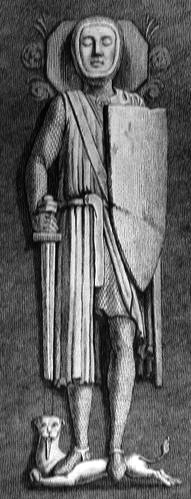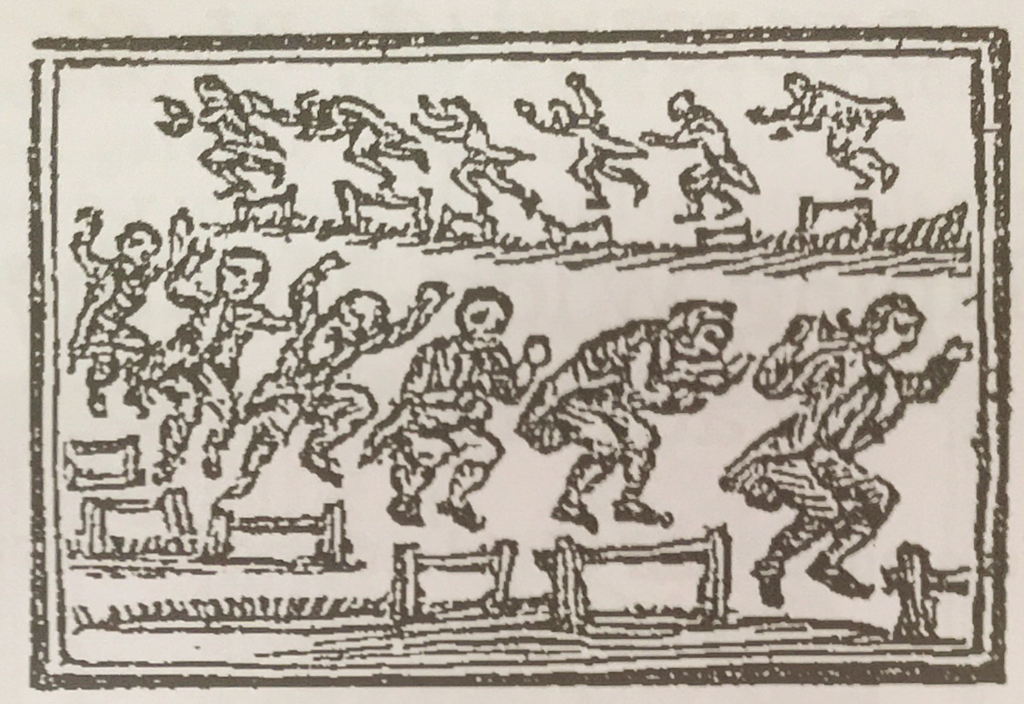On a summer’s day in 1189 a group of men rode swiftly to the quayside at Dieppe after a long journey from the Loire valley, two hundred and forty miles to the south. Keen to cross from Normandy to England with the least possible delay, they charged onto a boat waiting to transport them. Overloaded, the deck suddenly collapsed, pitching a tangle of splintering wood and falling bodies down into the hull. With quick reactions honed by over twenty years’ experience in tournament and battle, one man leapt forward to grasp a still intact deck strut. Catching firm hold at the cost of a wound to his leg, he hung by his hands above the heap of wreckage and broken limbs below.
This is just one of many vivid pictures recorded in the only surviving manuscript of what is now known as The History of William Marshal. Composed in the mid-1220s, this medieval precursor of the modern biopic covers the long career of its eponymous hero, famously described as ‘the best knight in the world’ (Le meillor chevalier del monde), in as much detail as possible in 19,214 lines of French verse.[1] Starting in the 1150s, when, as a younger son of a not particularly wealthy west Berkshire nobleman, the young William Marshal apparently charmed King Stephen with his fearless innocence as a child hostage, it is a career of special interest this year, the 800th anniversary of its conclusion, at Caversham, as regent of England (1216-19) for the young Henry III.[2]
 [Image credit: William Marshal, 1st Earl of Pembroke, 1786, from Sepulchral Monuments in Great Britain, Vol 1, by Richard Gough. Image from Wikimedia Commons.]
[Image credit: William Marshal, 1st Earl of Pembroke, 1786, from Sepulchral Monuments in Great Britain, Vol 1, by Richard Gough. Image from Wikimedia Commons.]
The History’s description of William Marshal’s leap for the deck strut in 1189 deftly highlights the crucial metaphorical leap forward he was achieving at precisely this point. A few weeks earlier, in the service of Henry III’s grandfather, Henry II, the Marshal had had the opportunity, temerity—and skill—to unhorse the king’s heir, Richard, the future Lionheart, then in rebellion against his dying father. Succeeding to the English throne shortly after this incident, Richard, instead of avenging his humiliation, had rewarded the Marshal’s loyalty to the old king with the late twelfth-century equivalent of the jackpot in a lottery rollover—the hand of one of the wealthiest heiresses of the day. A key object of William’s journey to Dieppe was to secure his prize by marrying her forthwith—as he then did, in London, notwithstanding the disgruntlement of her guardian, Henry II’s justiciar, Ranulf de Glanville (d. 1190), famed for his association with the twelfth-century law treatise, Glanvill.
Through his marriage to the heiress, Isabel de Clare, only surviving child of Richard fitz Gilbert de Clare, aka Strongbow (d. 1176), earl of Pembroke and lord of Leinster, the Marshal leapt into lordship—and wealth—on an infinitely grander scale than he had achieved through the few grants he had hitherto acquired in royal service. His new lands straddled Wales and Ireland as well as England and Normandy. He did not forget Isabel’s role in making this metaphorical leap possible. The History relates that two decades later he reminded his men in the Irish lordship of Leinster that she was their ‘lady by birth’ (dame naturalment), adding ‘I have no claim to anything here save through her’ (Ge n’i ai rien si par lui rien).[3] Later she is named among his most trusted advisers (Cels en qui il plus se fiot) as he considered, on his deathbed, who should succeed him as Henry III’s protector and regent of England.[4]
William Marshal’s leaps in 1189, and the power they brought him, enabled the next generation to leap into alliances with royalty—all noted, directly or indirectly, in the annals of Reading Abbey.[5] The eldest of his and Isabel’s five sons (another William) married Henry III’s sister, Eleanor (later the wife of Simon de Montfort); one of their five daughters, Isabella, married the king’s brother, Richard earl of Cornwall; third son Gilbert married Margaret, sister of Alexander II, king of Scots.
Other leapers in English medieval history readily spring to mind: for instance, Edward II’s favourite, Piers Gaveston, leaping from his Gascon knightly family into the earldom of Cornwall, marriage to the king’s niece, and temporary regency of England in 1307; Michael de la Pole leaping from a mercantile background into the earldom of Suffolk in 1385 via service to Richard II; his grandson, William, leaping from the earldom to a marquessate, then a dukedom, at the court of Henry VI in the 1440s. Leaping from a much lower level in the post-Black Death era, yet another William, Clement Paston’s son, rose from the peasantry to reach the equivalent of baronial rank as justice of common pleas in 1429, marrying a knight’s heiress en route. The many parallels in the Church of course include merchant’s son, Thomas Becket, as chancellor, then archbishop of Canterbury under Henry II, and the surprisingly high proportion of English bishops (60%) who sprang from non-noble families in the fifteenth century.
The careers of those achieving dramatic upward social mobility did not always end well. The fates of Gaveston, Duke William of Suffolk and Becket (his canonisation notwithstanding) are all cases in point. But if not ten a penny, the leaping lords of medieval England were not rare birds, but many.
Footnotes:
- [1] History of William Marshal, ed. A.J. Holden, S. Gregory and D. Crouch, Anglo-Norman Text Society, 3 vols (London, 2002-6), l. 19072.
- [2] See David Crouch, William Marshal (3rd edn, Abingdon, 2016); Thomas Asbridge, The Greatest Knight (London, 2015). To mark the anniversary, the Caversham and District Residents Association recently installed an information panel summarising the Marshal’s career on the east side of Caversham Bridge: www.cadra.org.uk.
- [3] HWM, ll. 13535, 13544.
- [4] HWM, l. 18036.
- [5] Reading Abbey Records: a new miscellany, ed. Brian Kemp, Berkshire Record Society, 25 (Reading, 2018), 34–7.

You must be logged in to post a comment.